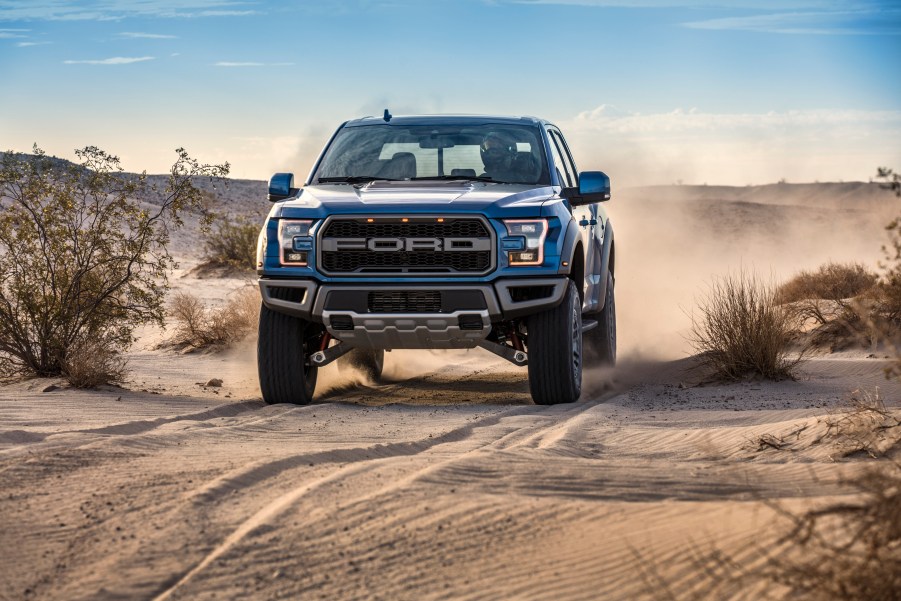
4WD vs AWD: The Ford F-150 Raptor Has Both
A huge advantage of the Ford F-150 Raptor is that it can take on just about any driving surface. Its prowess as a high-performance offroader is more than enough proof of that. Shifting from dry pavement to snow-covered tarmac or sandy trails is effortless for this truck.
Ford says that this technology is the first of its kind. But what’s the secret behind the Raptor’s versatility? Jason Fenske of Engineering Explained pulls the curtain away from this mystery in his YouTube video.
How AWD and 4WD differ
The Raptor’s ability to flip easily between AWD and 4WD modes is such a game-changer because of the big difference in how the drive shafts work for each driving mode. In an all-wheel-drive vehicle, the front driveshaft and the rear driveshaft operate at different speeds. This allows for a speed differential that helps the vehicle’s tires grip on slick road surfaces.
A four-wheel-drive vehicle, on the other hand, has a selectable mode that locks both axles. As a result, the front and rear driveshafts are rotating at the same speed. This mode works well for high-traction surfaces.
Considering how radically different the two modes are, the Raptor’s ability to switch between them as well as 2WD is no mean feat.
The trick is in the transfer case
Like many current AWD trucks, the Raptor has a two-speed transfer case with four modes:
- 2-High – standard rear-wheel drive
- 4-Auto – all-wheel drive in which power is sent to the front wheels when slip is detected
- 4-High – all four wheels are engaged in 4WD
- 4-Low – a 4WD crawl mode where all four wheels are engaged.
Fenske walks us through how the Raptor’s 4WD system works in the last two modes listed here. It has an enormous driveshaft on one side and a small half shaft on the other. Power is sent from the engine to transmission and then on to the transfer case that splits power between the front and rear driveshafts.
The optional Torsen front differential on the Raptor also continuously handles power delivery between the front axles helping to maximize available traction over a variety of driving surfaces. There are a limited-slip differential and a locking rear axle as well. All of these send power to the drive shafts as the AWD system demands.

When power moves from the transmission to the transfer case, it’s sent through a reduction gear that switches between high or low gear through a range selector. It continues to travel along the shaft to the 4WD selector that locks the two shafts so that they rotate at the same speed. A drive chain is connected to both driveshafts.
Between the drive chain and the rear driveshaft sits the wet multi-plate clutch. This electronic component is the key player in the Raptor’s 4-Auto mode because it helps to distribute power to the front and rear driveshafts according to traction demands. The clutch pack uses friction from the oil it’s bathed in as well as its stacked friction plates to create the amount of torque needed in a given driving mode.
The selector shaft is located between the 4WD selector and the drive chain. Operated by an electric motor, this shaft pushes the drivetrain’s selector forks into specific positions. These positions allow the driver to choose between high or low gear in 4WD and between connecting or disconnecting to the 4WD system altogether. Return springs force these forks back into place, depending on how the driveshafts rotate.
How the Raptor’s AWD system and its drive modes mesh
Two-wheel drive mode on the Raptor is its default mode. All of the engine’s power is sent directly across to the rear wheels because the front hubs that lock the front axle are disconnected.
If automatic AWD is selected, the front hubs are connected, allowing the front wheels to be driven. The clutch pack is electronically activated to apply pressure to the driveshaft to connect during slippery road conditions. The more pressure that is applied, the more lockup occurs. The driver thus has more control and, at the same time, the axles won’t bind as they would in 4WD mode.
When the Raptor is cruising along at 65 mph on dry pavement, its AWD disconnects automatically. Power is then being sent primarily to the rear wheels. Because power is not sent to all four wheels, the truck uses this energy more efficiently.

Off the pavement and in 4WD, the slip occurs at the wheels instead of within the drivetrain. For this reason, Fenske warns, AWD only should be used in offroad conditions because the axles will bind otherwise. If the driver uses the range selector to choose low gear, which allows the Raptor to crawl and put down more torque.
The Raptor has a drive mode selector on the steering wheel for choosing the optimal setting for AWD or 4WD. The Normal and Sport modes use the 2-High for two-wheel drive, with the Sport stepping up throttle response and steering effort. The Weather mode shifts the truck automatically into the 4-Auto or AWD mode.
Mud and Sand shifts the truck into 4WD and locks the rear differential. The Baja mode combines the Sport mode with Mud and Sand. Rock Crawl is the only drive mode that uses 4-Low to reduce slip and offer loads of torque at a low speed.


